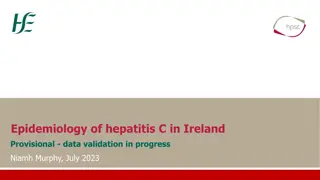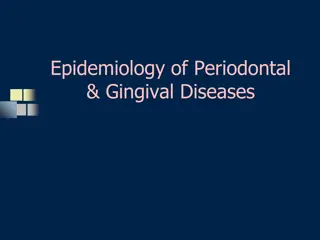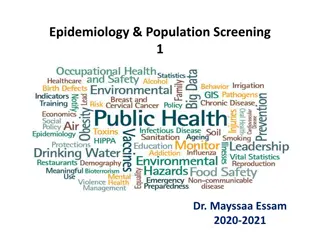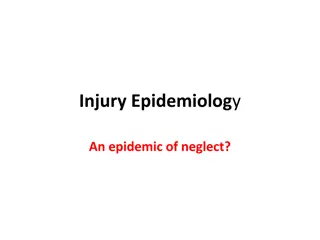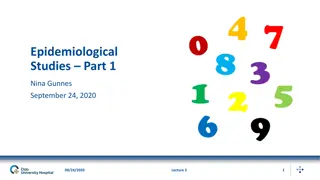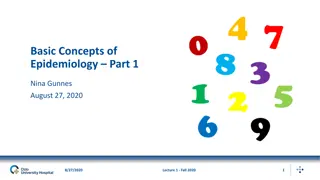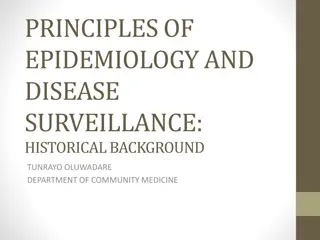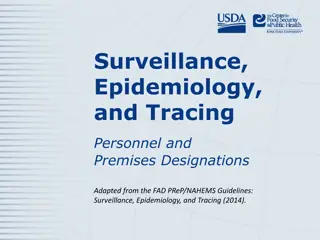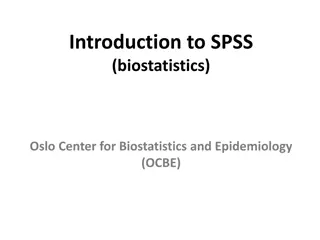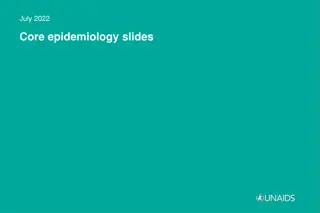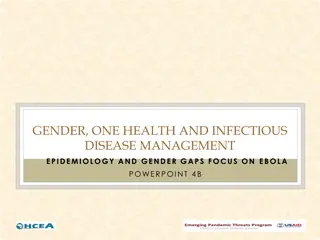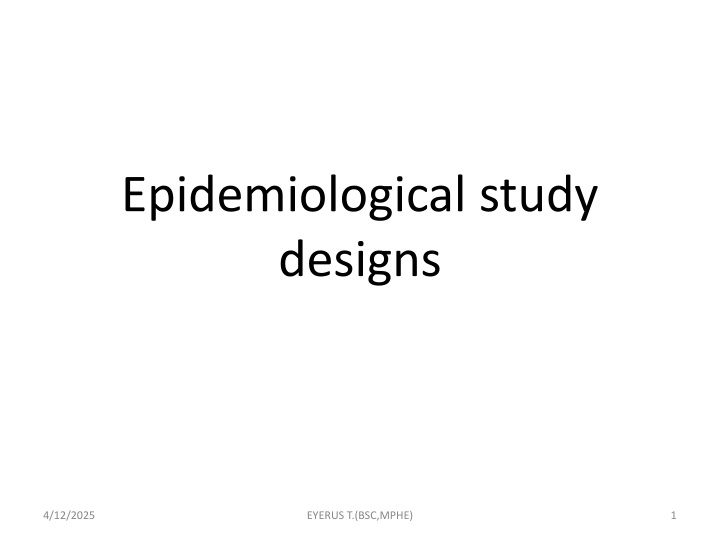
Epidemiological Study Designs: Types and Applications
Dive into the world of epidemiological study designs with this comprehensive guide by Eyerus T. Learn about the different types of study designs, their merits and demerits, and how to apply them effectively in research. Gain insights into descriptive and analytic studies, observational and intervention studies, as well as the importance of timing and direction in study design. Enhance your understanding of epidemiology and its role in diagnosing community health problems, identifying disease etiology, and planning health services. Start your journey towards conducting impactful epidemiological studies today!
Download Presentation

Please find below an Image/Link to download the presentation.
The content on the website is provided AS IS for your information and personal use only. It may not be sold, licensed, or shared on other websites without obtaining consent from the author. If you encounter any issues during the download, it is possible that the publisher has removed the file from their server.
You are allowed to download the files provided on this website for personal or commercial use, subject to the condition that they are used lawfully. All files are the property of their respective owners.
The content on the website is provided AS IS for your information and personal use only. It may not be sold, licensed, or shared on other websites without obtaining consent from the author.
E N D
Presentation Transcript
Epidemiological study designs 4/12/2025 EYERUS T.(BSC,MPHE) 1
Session objectives After completing this session you will be able to Understand epidemiological study designs Differentiate the type of study design used by investigators Identify the merits and demerits of each study designs Apply epidemiological study designs to conduct a study. 4/12/2025 EYERUS T.(BSC,MPHE) 2
Introduction Role of epidemiology To diagnose community health problems To identify natural history and etiology of diseases To evaluate and plan health services Therefore, to achieve these roles -------we use epidemiological study designs. The common goal in epidemiological studies is understanding the frequency, pattern, and causes of disease in populations. 4/12/2025 EYERUS T.(BSC,MPHE) 3
Epidemiology: is primarily concerned with the distribution and determinants of disease in human population. Study Design: is an arrangement of conditions for the collection and analysis of data that leads to the most accurate answer to the research question and the most economical way. 4/12/2025 EYERUS T.(BSC,MPHE) 4
Types of Epidemiologic study designs Based on objective/focus/research question 1. Descriptive studies Describe: who, when, where & how many 2. Analytic studies Analyse: How and why 4/12/2025 EYERUS T.(BSC,MPHE) 5
Types of study.. Based on the role of the investigator 1. Observational studies The investigator observes nature No intervention 2. Intervention/Experimental studies Investigator intervenes He has a control over the situation 4/12/2025 EYERUS T.(BSC,MPHE) 6
Types of study Based on timing 1. One-time (one-spot) studies Conducted at a point in time An individual is observed at once 2. Longitudinal (Follow-up) studies Conducted in a period of time Individuals are followed over a period of time 4/12/2025 EYERUS T.(BSC,MPHE) 7
Types of study Based on direction of follow-up/data collection 1. Prospective Conducted forward in time 2. Retrospective Conducted backward in time 4/12/2025 EYERUS T.(BSC,MPHE) 8
Types of study Based on type of data they generate 1. Qualitative studies Generate contextual data Also called exploratory studies 2. Quantitative studies Generate numerical data Also called explanatory studies 4/12/2025 EYERUS T.(BSC,MPHE) 9
Types of study Based on study setting 1. Community-based studies Conducted in communities 2. Institution-based studies Conducted in institutions 3. Laboratory-based studies Conducted in major laboratories 4/12/2025 EYERUS T.(BSC,MPHE) 10
Types of study 4/12/2025 EYERUS T.(BSC,MPHE) 11
Types of study 4/12/2025 EYERUS T.(BSC,MPHE) 12
Introduction (contd) Purpose of Epidemiological Studies Descriptive Analytic Characterize disease occurrence by time, place and person. Generate testable hypothesis as to the cause of disease Concerned with the search for causes and effects. Test hypothesis about association between exposure and outcome. 13 4/12/2025 EYERUS T.(BSC,MPHE)
Introduction (cont.) Types of Epidemiological Design Strategies Descriptive Dealing with population as a study unit Correlational or ecological Dealing with individual as study unit Case report or series Cross sectional survey Analytic Observational studies Case-control Cohort Intervention studies 14 4/12/2025 EYERUS T.(BSC,MPHE)
Selection of study design Depends on Hypothesis being tested Resources available Current state of knowledge 4/12/2025 EYERUS T.(BSC,MPHE) 15
Descriptive studies Relatively cheap in terms of time cost, because it can use information already collected. It usually describes: 1. Who gets a disease and who doesn t ( person) 2. Where rates are highest and lowest ( place) 3. Temporal patterns of disease (time) 4/12/2025 EYERUS T.(BSC,MPHE) 16
Descriptive It is the most common form of study in medical literatures There are three forms of descriptive study designs 1. Correlational /ecological design ( use population as study subject) 2. Case report and/or case series studies 3. Cross-sectional survey 4/12/2025 EYERUS T.(BSC,MPHE) 17
1. Correlational /ecological study Use data from entire population (as a whole) to compare disease frequencies. Hence, it does not need data from individuals. Can be done quickly and inexpensively, often by using already available data. It has the following rationale 1. Low cost and convenience 2. Measurement limitations at individual level, Eg environmental contact. 3. Other designs may be unable to measure interest on ecologic effect 4/12/2025 EYERUS T.(BSC,MPHE) 18
Correlational/ecological. For initial investigation of causal hypothesis like a cross-sectional study design data on both the exposure and outcome of interest will be collected at one time (simultaneously). However the exposure and outcome of interest measured at group and not at individual level. 4/12/2025 EYERUS T.(BSC,MPHE) 19
Correlational/ecological studies Uses data from entire population to compare disease frequencies between different groups during the same period of time, or in the same population at different points in time. Time series may reduce some of the socioeconomic confounding that is a potential problem in ecological studies Does not provide individual data, rather presents average exposure level in the community Cause could not be ascertained Correlation coefficient (r) is the measure of association in Correlational studies. 20 4/12/2025 EYERUS T.(BSC,MPHE)
Correlational/ecological studies (cont.) Example: Average per capita fat consumption and breast cancer rates compared between countries. Comparing incidence of dental cares in relation to fluoride content of the water among towns in the rift valley. Mortality from CHD in relation to per capita cigarette sales among the regions of Ethiopia. Relationship between average sales of an anti-asthma drug and the occurrence of an unusually high number of asthma deaths in different provinces of New Zealand. 21 4/12/2025 EYERUS T.(BSC,MPHE)
Correlational/ecological studies (cont.) Strength Can be done quickly, inexpensively, and often using available data (routine records and reports-- for example, death rates, per capita income, national food consumption ) Low cost/cheap and convenience Measurement limitations at individual level, Eg environmental contact. Other designs may be unable to measure Interest on ecologic effect 22 4/12/2025 EYERUS T.(BSC,MPHE)
Correlational/ecological studies (cont.) Limitation Inability to link exposure with disease in a single individual. Data on exposure and outcome are not linked at the individual level; association found with aggregate data (average values) may not apply to individuals (Prone to ecological fallacy) Average exposure levels rather than actual individual values, ecological fallacy or bias. Lack of ability to control for effects of potential confounding factors. Conversely, lack of correlation does not necessarily imply absence of valid statistical association (Berksons fallacy) It may mask a non-linear relationship between exposure and disease. E.g. non-linear relationship in alcohol consumption and mortality from CHD ("J" shaped curve) 23 4/12/2025 EYERUS T.(BSC,MPHE)
Case Reports (Case series) Report or describe the experience of a single individual or a group of individuals with the same diagnosis or health problem Derived from either the practice of one or more health care professionals or a defined health care setting ( hospital, health centre or specialized clinic) 24 4/12/2025 EYERUS T.(BSC,MPHE)
Case Reports (Case series) 2.1. Case study/report A most basic type of descriptive study of individuals comprising of a careful and detailed report of a single patient by one or more physician E.g. the progress of symptom and sign, response of treatment It is the study of health profile of a single individual using a careful and detailed report by one or more clinicians It is common form that is published in articles It is made using Simple history, physical examination and Lab./ radiologic investigation 4/12/2025 EYERUS T.(BSC,MPHE) 25
Case Reports Useful for the recognition of new disease Important for constructing the natural history of disease Help to formulate a research hypothesis and detection of epidemics It was a single case report that formulated the hypothesis of oral contraceptive use increases venous thrombo-embolism 26 4/12/2025 EYERUS T.(BSC,MPHE)
Case report :Limitations No appropriate comparison group Cannot be used to test for presence of a valid statistical association Since based on the experience of one person: Presence of any risk factor may be coincidental Not a true epidemiologic design 4/12/2025 EYERUS T.(BSC,MPHE) 27
Case Reports (Case series) 2.2. Case series A sequence of case reports with common elements such as similar clinical features and suspected common exposures Individual case report can be expanded to a case series, which describes characteristics of a number of patients (usually 5-12) with a similar disease Similar to case report, it is usually made on cases having new and/ or unusual disease (giving interest to clinicians) It is often used to detect the emergence of new disease or an epidemics 4/12/2025 EYERUS T.(BSC,MPHE) 28
Examples of case-series studies Five young, previously health homosexual men were diagnosed as having Pneumocystis carinii pneumonia at Los Angeles hospital during a six month period from 1980 to 1981 This form of pneumonia had been seen almost exclusively among older men and women whose immune systems were suppressed This unusual circumstance suggested that these individuals were actually suffering with a previously unknown disease, subsequently it was called AIDS 4/12/2025 EYERUS T.(BSC,MPHE) 29
Uses of case series studies Can be valuable early evidence for associations between exposures and diseases which can be studied in more detail Useful for the recognition of new diseases Useful for constructing of the natural history of a disease, Use to formulate a hypothesis and to detect an epidemic 4/12/2025 EYERUS T.(BSC,MPHE) 30
Limitations of series studies Are able to formulate a hypothesis but are not able to test for presence of valid association Their fundamental limitation is presence of a risk factor that is simply coincidental (by chance) It is difficult to test for association because there is no relevant comparison group Case-series lack a control (comparison) group, and so can result in false leads, wasted energy and resources 31 4/12/2025 EYERUS T.(BSC,MPHE)
Case Reports (Case series) (cont.) Strength: useful for studying signs and symptoms (new syndromes) and creating case definitions for epidemiological studies. Example: AIDS Case-series that include cases at various stages of an illness from mild cases to dead supplemented by investigation of the past medical history of these cases and observing them to death (doing autopsy as appropriate) can help build up a picture of the natural history of a disease Very useful in providing critical information, for hypothesis generation. 32 4/12/2025 EYERUS T.(BSC,MPHE)
Case Reports (Case series) (cont.) Limitation: Report is based on single or few patients, which could happen just by coincidence Lack of an appropriate comparison group Rates can not be calculated since the population corresponding to the source of cases can not be defined well Detailed and complete risk factor information is difficult to obtain for all cases from records Studies are prone to atomistic fallacy (the opposite of ecological fallacy). Example: at an individual level a high income may be associated with lower rate of suicide but this does not mean that societies which are rich have a lower rate of suicide. 4/12/2025 EYERUS T.(BSC,MPHE) 33
Cross-Sectional Studies /prevalence survey/ Measure disease and exposure status simultaneously among individuals in a well-defined population at a point in time Is generally called prevalent study Snapshot of the health status of populations at a certain point in time Steps in the conduct of cross-sectional studies: 1. Define a population of interest (reference population) 2. Recruiting a representative sample (adequate size, random selection) 3. Measure the variables of interest (disease &or exposure) at the same point in time 4. Sorting (if necessary) & Analyze the data 34 4/12/2025 EYERUS T.(BSC,MPHE)
Cross-Sectional Studies (cont.) Characteristics of cross-sectional studies: Assess both exposure and outcome simultaneously Are based on point prevalence rates Are frequently made on total population samples Subdivision of the total population takes place after data collection unlike in cohort & case- control studies Are cheaper, easier & useful for studies of exposures that are unalterable over time or relatively permanent features for individuals E.g.-blood group, ethnicity, sex, etc. 35 4/12/2025 EYERUS T.(BSC,MPHE)
Cross-Sectional Studies (cont.) Data are obtained only once Individuals with a defined disease, risk factor, or other condition of interest are identified at a point in time May be used first step in longitudinal or case control studies Can have descriptive or analytic purposes The descriptive type is carried out to study prevalence of health related events at a point in time/snapshot Diseases, risk factors, coverage of interventions, health service utilization, knowledge, attitude and practice The analytic type is carried out to assess association between exposure and outcome Exposure and disease status are assessed simultaneously among individuals at the same point in time Measures of association is made using odds ratio 4/12/2025 EYERUS T.(BSC,MPHE) 36
Cross-Sectional Studies (cont.) Since exposure and disease status is assessed at a single point in time, temporal relationship between exposure and disease can not be clearly determined Egg and hen phenomena Study prevalent cases rather than incident cases The person might have changed the behaviour that resulted to the disease Prevalent cases represent survivors who may be atypical with respect to exposure status Incidence-prevalence/selective survival/Neyman s bias Therefore identify a mix of risk factors (incidence) and prognostic factors (duration) Best used for screening hypotheses if in etiological search Generally provide weak evidence regarding causation 4/12/2025 EYERUS T.(BSC,MPHE) 37
Factors Influencing Ds Prevalence Decreased by: Shorter duration of disease Increased by: Longer duration of the disease Prolongation of life of patients without cure High case-fatality rate from disease Increase in new cases (increase in incidence) Decrease in new cases (decrease in incidence) In-migration of cases In-migration of healthy people Out-migration of healthy people In-migration of susceptible people Out-migration of cases Improved cure rate of cases Improved diagnostic facilities (better reporting) 38 4/12/2025 EYERUS T.(BSC,MPHE)
Cross-Sectional Studies (cont.) Advantages Less expensive: a one-step, one-time collection of data It starts with reference population, thus making possible generalization Provide much information useful for planning health services & medical programs Show relative distribution of conditions, Diseases, injury & disability in groups & populations Are based in a sample of a major population & do not relay on individuals that present themselves for medical treatment. 39 4/12/2025 EYERUS T.(BSC,MPHE)
Cross-Sectional Studies (cont.) Disadvantages It is difficult to know which occurred first, the exposure or the outcome, this is known as 'chicken or egg dilemma' It may not show strong cause-effect relationship if sample size is small Potential bias in measuring exposure Not feasible for rare diseases Does not yield incidence or true relative risk Prevalent rather than incident (new) cases are used the exposure could be associated with survival after dx occurrence, rather than development of the disease Temporal sequence between exposure and disease cannot be established * i.e. which came first, chicken or the egg? 40 4/12/2025 EYERUS T.(BSC,MPHE)
ANALYTIC EPIDEMIOLOGIC STUDY PURPOSE To test hypothesis about causal relationship To search for cause & effect To compare treatment regimens / prevention programs To assess diagnostic tests To quantify the association b/n exposure & outcome (measure of association) Focuses on determinants of diagnosis by testing hypothesis 4/12/2025 EYERUS T.(BSC,MPHE) 41
Basic Question in Analytic Epidemiology Are exposure and disease linked? Exposure Disease Look to link exposure and disease What is the exposure? Who are the exposed? What are the potential health effects? What approach will you take to study The relationship between exposure and effect? 4/12/2025 EYERUS T.(BSC,MPHE) 42
Time frame of Studies Prospective Study looks forward, looks to the future, examines future events, follows a condition, concern or disease into the future Retrospective Study to look back , looks back in time to study events that have already occurred 4/12/2025 EYERUS T.(BSC,MPHE) 43
Types of analytic study design There are two types of analytic study designs Observational- to simply observe Interventional - manipulation or determination OBSERVATIONAL STUDIES Information is obtained by simple observation of the event (two basic types): - Case control study Cohort study Cross sectional (some times) 4/12/2025 EYERUS T.(BSC,MPHE) 44
Case-Control Studies Syn: case-comparison study, case-referent study, retrospective study Defn: past history of exposure is compared in cases and their controls for their exposure status Look back at exposure (retrospective) - It assess retrospectively on exposure status. Case control studies aim to identify potential associations between risk factors or exposure and a particular disease or outcome 4/12/2025 EYERUS T.(BSC,MPHE) 45
Case-Control Studies Unit of observation and analysis: Individual (not group) Case-control studies are the most frequently undertaken analytical epidemiological studies They are the only practical approach for identifying risk factors for rare diseases They are best suited to the study of diseases for which medical care is sought, such as cancers or hip fracture It is relatively cheaper Measure of association is using OR 4/12/2025 EYERUS T.(BSC,MPHE) 46
Case control study Exposed Cases (people with disease) Non exposed Controls (people without the disease Exposed Non exposed Direction of inquiry past time present time 4/12/2025 EYERUS T.(BSC,MPHE) 47
Case-control design Select a group of subjects with disease (cases) and Try to characterize their pre-disease exposure status Select a group of subjects without disease (controls) try to characterize their exposure status Compare how common exposure was among cases with how common it was among controls, as a measure of exposure-disease association (measure of association) 4/12/2025 EYERUS T.(BSC,MPHE) 48
Outcome in case control study Can we study outcome other than disease ? The outcome has traditionally been the presence or absence of disease. However, other outcomes can also be studied e.g. disability, smoking cessation etc. Start by defining a CASE Clinical definition insufficient list of criteria Reproducibility certainty of diagnosis Severity 4/12/2025 EYERUS T.(BSC,MPHE) 49
Selection of Cases Select cases after the diagnostic criteria and definition of the disease is clearly established Study cases should be representative of all cases The study need not include all cases in the population Cases may be located from hospitals, clinics, disease registries, screenings, etc Incident cases are preferable to prevalent cases for reducing Recall bias over-representation of cases of long duration 4/12/2025 EYERUS T.(BSC,MPHE) 50


